 |
 |
|
|
 |
 |
 |
 |
 |
 |
Lviv. The railway station |
 |
 |
 |
 |
 |
 |
|
|
|
Allegorical figures welcome people arrived to Lviv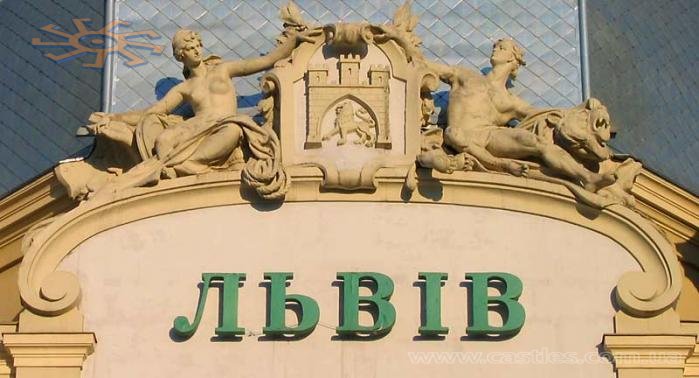 |
The full face views. On some postcards by means of photomontage, a prototype of Photoshop, images of cars were applied, as it is fashionably and prestigiously. It’s interesting to compare the second and the third shot: the same photo with the same man in a close shot, and the street traffic is depending on ambitions of the person engaged in photomontage. And here in the first and last picture trams look fully inherently.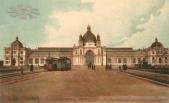 |
The most photogenic view is made in three quarters. Dvirets sits not only for photographers and for artists. And now from contrariwise... Please, pay attention to quantity of fiacres which are waiting for people arrived in coaches. Not only in the current moment it is difficult to leave the station without constant hails: <i>"The taxi, miss, the taxi!.."</i> On the third photo there is both a fiacre, and a mean of transportation for not so prosperous people – a tram.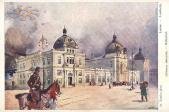 |
Landing-stage is a miracle of engineering thought of the break of centuries. If I don't miss my guess it is created in 1901-1903. It still exists.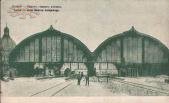 |
The Lviv railway station is quite worthy of its name - Dvirets (the palace in Polish). As it has so much from a palace as from a transitional point where preoccupied with cares and nervous newcomers stumble across those who depart. And all it happens among taxi drivers, police officers and loaders of luggage.
Even the square where the main Lviv station is situated bears the name “Dvirtseva” (Palace's). It is all true. There is a magnificent décor, weight of allegorical sculptural figures, the roof of refined form, huge windows, even something like atrium - a glass dark yellow ceiling in the main hall. Though it is not the Versailles, but it is also not a grey concrete box. Do you know the best station in Ukraine? There are, of course, applicants for such a rank, for example let’s say|name Zmerenka’s or Chernivtsy's station... But Lviv’ll finish quickly with them in double-quick time: with the first – by its Austro-Hungarian refinement, with the second – by its considerably bigger size.
Besides the Lviv Dvirets has an ace in the hole. It has a glass and steel landing-stage (a covered platform) made by the Czech masters. Five fingers of one hand are enough to count them across the Europe. I read once, that its design was unique during times of creation (1903). I believe.
The landing-stage, which is a pride of a city, was compared to the web which had been stretched on stems growing from concrete. This metaphor is a little bit terrible, but figurative.
Nowadays only the sizes remind of its archaism: modern trains are considerably longer than those driving between Lviv and Chernovtsy or Vienna in 1900-th years. All coaches do not go into the “shed”. 
The document of loan of 1866 on building of the railway Lviv-Chernivtsy. |
It’s a clear thing, the Lviv station is not the first. Dvirets – predecessor of 1861 was relegated to oblivion. It was situated on a place of a modern suburban station, and after 1866 it received a popular name “Chernovitsky”. You can see here how it looked.
The press wrote about it in such a way:
"... As to the main building it is one of the best constructions in Europe. Its length is 70 sazhens, and width is 10 sazhens... (The Austrian sazhen is equal to 1,8965m.). In the future it will serve as a basic point for four railways: from Lviv to Krakiw, to Chernivtsy, to Brody and to Tomashev the total length of which will make 110 miles".
Its construction finished in October of 1861, and in a month, at 10 a.m. on November, 4th, in day of a name-day of grand duke Karl-Ljudvig, the long-awaited train left Pshemisl. It was hauled by brand new locomotive "Yaroslav". The capital of Galicia and Lodomeria eventually received a railway communication.
Let’s quote "Gazeta Lwowska":
"After long expectation a joyful day from which regular movement on the railway of Karl-Ljudvig will begin, brings closer. It will directly connect Lviv with the whole network of the European railways. By mean of railway the East Galicia will be connected with the civilised Europe... will form a way which will lie from eastern frontiers of Austria up to coast of Adriatic sea. The capital of region, as well as in general Galicia, will have henceforth the possibility to increase the activity of the craft and the facilitated trade".

The station which is the main Lviv door in the world now, had been built for two years (quickly enough!) was unveiled on March, 26th, 1904. Thenadays it was one of the biggest and the most convenient stations of Europe.
Nevertheless at the beginning of ХХ century the need of a new Dvirets took shape: a huge passenger traffic passed through a city, the compact Chernovitsky station did not contain all the travelers.
A new Dvirets was necessary. The matter was solved seriously: among townsmen of Lviv the referendum was held (!) to resolve the question where exactly a new station to be placed. Among the offered places there were both the city centre, and the crossing of the present streets of S.Bandera and O.Nevskij, and the top part of the Jesuit garden (this park is near to the university). The chosen place was selected not in the last resort through the relative cheapness of the price of the ground area.
Tenders for a contract were invited. The project-winner was worked by architects Kupriainov, Sadlovskij and Zaritskij on. The sculptural design of the main portal was executed by known Lviv sculptors Piotr Wójtowycz (he is the person who created allegories of Lviv and railway which hold a cartouche with the city arms) and Anton Popel (its figures "Trade" and "Industry" are placed in niches near to a main entrance), and the basic civil works were performed by the widely known firm of professor Ivan Levitskogo. A roof was projected by the Czech masters.
The length of Lviv Dvirets makes 150 hec. Before the construction was one-storeyed, in Viennese setsession style. It is already later after ruins of the Second world war reorganisations introduced the corrective amendments to the purity of style. There were economic premises and baggage compartment on the left, a post office was constructed later on the right. A facade was painted in white, a dome and gate was painted in green. 
On basis of drafts of the author of the project of Dvirets, Vladislav Sadlovskij, J.Goretski's Krakow factory executed the main gate from the forge iron decorated with a vegetative ornament. The forged handrails of five cash desks of the first and the second class reminded flexible lianas. Floristic infatuation of a modernist style proved out.
And what is there inside? The station was equipped with state-of-the-art achievements of technical thought: ventilation, electric heating, 70 electric clocks, and electric lifts for workers, electric illumination. Five underground tunnels leaded to platforms. And spit and polish as usual.
On the right side the entrance to the post, telegraph and phone is settled down. On the left-hand side there is a newsstand, further a there is tobacco shop. And then an exedra decorated with frescos about the history of development of transport, with a stained-glass window "The Archangel Michael" and modelled beadings can be seen.
Station soon after the opening.

Tygodnik Ilustrowany, 1867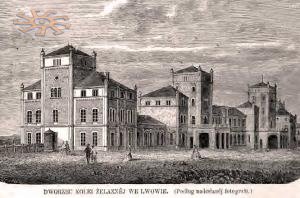 |
Now many stations arrive at an idea that waiting rooms, these limbos of a travelers’ life, to be divided into a hell of free halls and paradise of paid halls. After several decades of the general egalitarianism the history turned on 360 degrees: such a situation was also a century ago. Passengers of the first and the second class could have a rest in fine armchairs at the special halls decorated with a moulding, or at a restaurant. And for those who travelled in the third class, a waiting room was designed in folk style. In principle, it is logical. "Passengers of the third class" were prohibited to come through the main entrance: their way run directly through underground passage to the 5th platform, whence suburban trains departed.
There was the royal (or deputy) hall for VIP-persons.
During the war the railway station was a target for the enemy. In 1916 Dvirets was bombarded. Not unsuccessfully. In 1919 it was destructed again. The facade was saved by a miracle.
In 1930 during the restoration of construction Dvirets grew up on one floor and in nine years, in the first day of the war, on September, 1st, bombs again stroke the station. In 1941 the landing-stage was badly cut up in bombing. After the war the construction was in such awful condition that the possibility of building of a new station was discussed.
By a century celebrated in 2004, Dvirets was thoroughly repaired. And on lithograph which is near, you can see the predecessor of the present Lviv station of the sample of 1867.
Translated by Dictum Factum (Kyiv) 
|
|

|

|
 |
|
"Замки і храми України" - некомерційний cайт, що підтримується фактично силами і ентузіазмом однієї людини. Допомогти проекту:
гривневий рахунок 4441 1111 4632 5091
євровий - 5168757402858452
Patreon
Ваш внесок допоможе не зневіритися в тому, що роблю вже 20 років. Дякую.
Екскурсійний супровід у мандрівці Кам'янцем-Подільським, Поділлям та Західною Україною в цілому: kamienczanka@gmail.com 
© All rights reserved.
Всі права на матеріали охороняються у відповідності до законодавства України.
Будь-яке використання матеріалів сайту можливе лише за попередньою узгодженністю |
Розробник 
|
|
|

